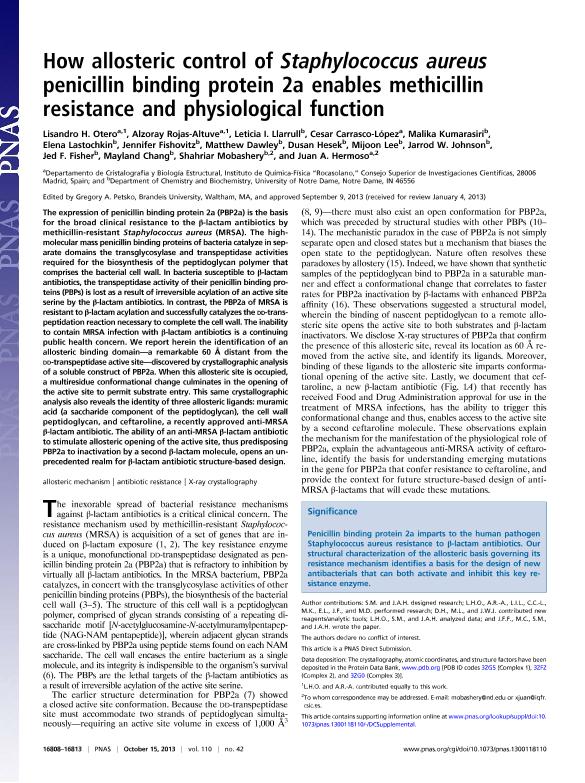Mostrar el registro sencillo del ítem
dc.contributor.author
Otero, Lisandro Horacio

dc.contributor.author
Rojas Altuve, Alzoray
dc.contributor.author
Llarrull, Leticia Irene

dc.contributor.author
Carrasco López, Cesar
dc.contributor.author
Kumarasiri, Malika
dc.contributor.author
Lastochkin, Elena
dc.contributor.author
Fishovitz, Jennifer
dc.contributor.author
Dawley, Matthew
dc.contributor.author
Hesek, Dusan
dc.contributor.author
Lee, Mijoon
dc.contributor.author
Johnson, Jarrod W.
dc.contributor.author
Fisher, Jed F.
dc.contributor.author
Chang, Mayland
dc.contributor.author
Mobashery, Shahriar

dc.contributor.author
Hermoso, Juan A.
dc.date.available
2020-01-09T21:24:18Z
dc.date.issued
2013-10
dc.identifier.citation
Otero, Lisandro Horacio; Rojas Altuve, Alzoray; Llarrull, Leticia Irene; Carrasco López, Cesar; Kumarasiri, Malika; et al.; How Allosteric Control of Staphylococcus aureus Penicillin-Binding Protein 2a Enables Methicillin-Resistance and Physiological Function; National Academy of Sciences; Proceedings of the National Academy of Sciences of The United States of America; 110; 42; 10-2013; 16808-16813
dc.identifier.issn
0027-8424
dc.identifier.uri
http://hdl.handle.net/11336/94276
dc.description.abstract
The expression of penicillin binding protein 2a (PBP2a) is the basis for the broad clinical resistance to the β-lactam antibiotics by methicillin-resistant Staphylococcus aureus (MRSA). The highmolecular mass penicillin binding proteins of bacteria catalyze in separate domains the transglycosylase and transpeptidase activities required for the biosynthesis of the peptidoglycan polymer that comprises the bacterial cell wall. In bacteria susceptible to β-lactam antibiotics, the transpeptidase activity of their penicillin binding proteins (PBPs) is lost as a result of irreversible acylation of an active site serine by the β-lactam antibiotics. In contrast, the PBP2a of MRSA is resistant to β-lactam acylation and successfully catalyzes the DD-transpeptidation reaction necessary to complete the cell wall. The inability to contain MRSA infection with β-lactam antibiotics is a continuing public health concern. We report herein the identification of an allosteric binding domain - a remarkable 60 Å distant from the DD-transpeptidase active site - discovered by crystallographic analysis of a soluble construct of PBP2a. When this allosteric site is occupied, a multiresidue conformational change culminates in the opening of the active site to permit substrate entry. This same crystallographic analysis also reveals the identity of three allosteric ligands: muramic acid (a saccharide component of the peptidoglycan), the cell wall peptidoglycan, and ceftaroline, a recently approved anti-MRSA β-lactam antibiotic. The ability of an anti-MRSA β-lactam antibiotic to stimulate allosteric opening of the active site, thus predisposing PBP2a to inactivation by a second β-lactam molecule, opens an unprecedented realm for β-lactam antibiotic structure-based design.
dc.format
application/pdf
dc.language.iso
eng
dc.publisher
National Academy of Sciences

dc.rights
info:eu-repo/semantics/openAccess
dc.rights.uri
https://creativecommons.org/licenses/by-nc-sa/2.5/ar/
dc.subject
ALLOSTERIC MECHANISM
dc.subject
ANTIBIOTIC RESISTANCE
dc.subject
X-RAY CRYSTALLOGRAPHY
dc.subject.classification
Bioquímica y Biología Molecular

dc.subject.classification
Ciencias Biológicas

dc.subject.classification
CIENCIAS NATURALES Y EXACTAS

dc.subject.classification
Biofísica

dc.subject.classification
Ciencias Biológicas

dc.subject.classification
CIENCIAS NATURALES Y EXACTAS

dc.title
How Allosteric Control of Staphylococcus aureus Penicillin-Binding Protein 2a Enables Methicillin-Resistance and Physiological Function
dc.type
info:eu-repo/semantics/article
dc.type
info:ar-repo/semantics/artículo
dc.type
info:eu-repo/semantics/publishedVersion
dc.date.updated
2020-01-09T17:35:55Z
dc.journal.volume
110
dc.journal.number
42
dc.journal.pagination
16808-16813
dc.journal.pais
Estados Unidos

dc.journal.ciudad
Washington
dc.description.fil
Fil: Otero, Lisandro Horacio. Consejo Superior de Investigaciones Científicas. Instituto de Química Física; España. Consejo Nacional de Investigaciones Científicas y Técnicas. Centro Científico Tecnológico Conicet - Rosario. Instituto de Biología Molecular y Celular de Rosario. Universidad Nacional de Rosario. Facultad de Ciencias Bioquímicas y Farmacéuticas. Instituto de Biología Molecular y Celular de Rosario; Argentina
dc.description.fil
Fil: Rojas Altuve, Alzoray. Consejo Superior de Investigaciones Científicas. Instituto de Química Física; España
dc.description.fil
Fil: Llarrull, Leticia Irene. University of Notre Dame; Estados Unidos. Consejo Nacional de Investigaciones Científicas y Técnicas. Centro Científico Tecnológico Conicet - Rosario. Instituto de Biología Molecular y Celular de Rosario. Universidad Nacional de Rosario. Facultad de Ciencias Bioquímicas y Farmacéuticas. Instituto de Biología Molecular y Celular de Rosario; Argentina
dc.description.fil
Fil: Carrasco López, Cesar. Consejo Superior de Investigaciones Científicas. Instituto de Química Física; España
dc.description.fil
Fil: Kumarasiri, Malika. University of Notre Dame; Estados Unidos
dc.description.fil
Fil: Lastochkin, Elena. University of Notre Dame; Estados Unidos
dc.description.fil
Fil: Fishovitz, Jennifer. University of Notre Dame; Estados Unidos
dc.description.fil
Fil: Dawley, Matthew. University of Notre Dame; Estados Unidos
dc.description.fil
Fil: Hesek, Dusan. University of Notre Dame; Estados Unidos
dc.description.fil
Fil: Lee, Mijoon. University of Notre Dame; Estados Unidos
dc.description.fil
Fil: Johnson, Jarrod W.. University of Notre Dame; Estados Unidos
dc.description.fil
Fil: Fisher, Jed F.. University of Notre Dame; Estados Unidos
dc.description.fil
Fil: Chang, Mayland. University of Notre Dame; Estados Unidos
dc.description.fil
Fil: Mobashery, Shahriar. University of Notre Dame; Estados Unidos
dc.description.fil
Fil: Hermoso, Juan A.. Consejo Superior de Investigaciones Científicas. Instituto de Química Física; España
dc.journal.title
Proceedings of the National Academy of Sciences of The United States of America

dc.relation.alternativeid
info:eu-repo/semantics/altIdentifier/url/http://www.pnas.org/cgi/pmidlookup?view=long&pmid=24085846
dc.relation.alternativeid
info:eu-repo/semantics/altIdentifier/doi/https://doi.org/10.1073/pnas.1300118110
dc.relation.alternativeid
info:eu-repo/semantics/altIdentifier/url/https://www.ncbi.nlm.nih.gov/pmc/articles/PMC3800995/
Archivos asociados
